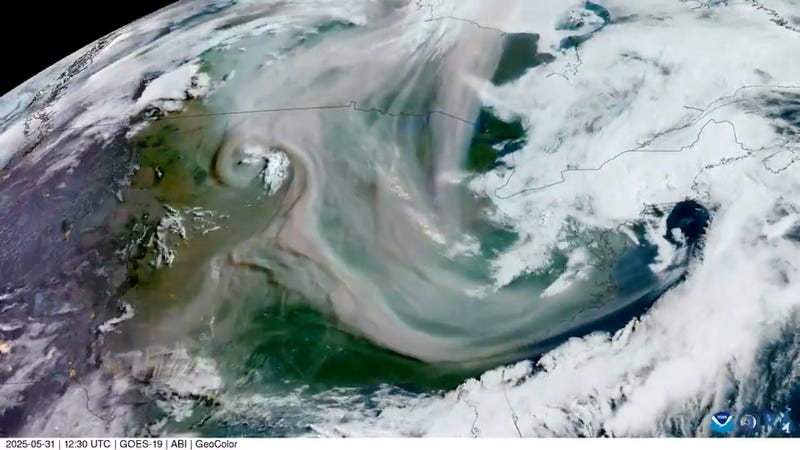
Facing yet another Air Quality Alert is Minnesota, along with many other places. The current alert covers all of Minnesota, much of Wisconsin, and the Upper Peninsula of Michigan.
It's set to expire Tuesday morning, but it's already been a summer with long, sustained air quality issues across the Upper Midwest, and those Canadian wildfires continue to be an issue.
"Every day I'm seeing people who've had a difficult stretch because of the poor air quality," says Allina Doctor Andrew Stiehm who is a pulmonologist.
Stiehm says the air is unhealthy and people should take care, and not exert themselves over the next few days outside.
"When you're exercising, you're breathing deeper, you're breathing more, so you're getting more of the stuff into you," he says. "And if you're going to go out, go out early, before the air quality index starts to really climb and get worse and get into that red zone."
Exercising outside can make it worse - with high school football starting
The Air Quality Alert comes on a day, Monday, that is the first practice day for Minnesota high school football teams, and for high school all across the Midwest.
Osseo, MN head coach Derrin Lamker talked with Tom Hauser on the WCCO Morning News and says football practice may not be what many remember from years ago. It's a more relaxed introduction to the sport than past years, with frequent breaks and time off between drills, good news on a day where breathing across Minnesota might be more difficult.
"You know, it works out really well," says Lamaker. "It's not like back in 1975 where we need to run laps all day long and never give them water. So we've kind of adapted with the time, so it's been a lot of fun. There's some really good rule changes that we've made."
Still, Stiehm says this is not a situation to overlook and that there are consequences to prolonged exposure to wildfire smoke.
"It certainly does increase risk of cardiovascular disease, cancers, emphysema and lung damage," says Stiehm. "And so, we do see that repetitive long-term exposure can have negative health consequences. I hope that doesn't become a growing trend."
Republican lawmakers call on Canada to do more to fight blazes
A group of Republican lawmakers sent a letter to Canada complaining that smoke from Canadian wildfires is ruining summer for Americans. That included lawmakers from Minnesota and Wisconsin, and that note was not well-received north of the border.
Tom Hauser on the WCCO Morning News asked one of those letter writers, Minnesota 8th District Congressman Pete Stauber, if they ever got a response from Canada.
"Yes, we did. It was very a stark reply, but the fact of the matter, when Minnesota's been under a unhealthy air health alert since late June, it's terrible that we have to breathe this," Stauber said. "This smoke and ruin our summers. Our summers are short enough and to have this?"
Stauber blames poor management of the forests in Canada.
"You can really remove a lot of the debris and a lot of the fuel for these that start the forest fires," Stauber claims. "So, I was disappointed in their response. But the fact of the matter is, we in Minnesota, we shouldn't have to breathe that smoke-filled air that really devastates our summers and our health."
Canadian wilderness and climate change make it difficult
There are literally hundreds of fires - some burning in extremely remote areas of Canada. The world's second largest country by area contains millions of acres of wilderness making it nearly impossible to reach some fires, let alone provide firefighters the support needed to battle the blazes.
The National Oceanic and Atmospheric Administration also adds climate change isn't helping matters. Research shows that changes in climate create warmer, drier conditions, leading to longer and more active fire seasons. Increases in temperatures and the thirst of the atmosphere due to human--caused climate change have increased aridity of forest fuels during the fire season.
“A warm and dry finish to May and early June has created a significant fire season,” said Liam Buchart, a fire weather specialist with the Canadian Forest Service.
The weather conditions are made more likely by climate change and encourage wildfires to start. That means even though 90% of wildfires in Manitoba this year have been human-caused, according to the provincial government, climate change helps enable their spread.
“Climate change is creating the conditions that make it more likely that human-caused fires are going to spread, or even start,” MacCarthy said. “It might be a human starting it, but it’s going to spread quickly because now there’s hot and dry conditions that are occurring more frequently and more intensely than they have in the past.”
The hot and dry weather is likely to to continue for at least the next week across Manitoba, Saskatchewan and Alberta, according to Natural Resources Canada. The agency’s forecasts also call for “a warmer and drier than normal July and August for large portions of Canada,” Buchart said.
“The remainder of the fire season looks to remain above normal, especially over the northern prairie provinces and southern British Columbia,” he said.
The fires are far from limited to Canada. Over three-dozen wildfires are burning across nine states in the Western U.S. with continued heat expected to worsen conditions.
In Arizona, the nation's largest active fire, the Dragon Bravo, has been burning near the north rim of the Grand Canyon since July 4th. It's nearly 40% contained. In Colorado, the Lee Fire has been burning for more than a week. This wildfire has prompted additional evacuations, including inmates who were removed from a prison Saturday night when flames came dangerously close.
